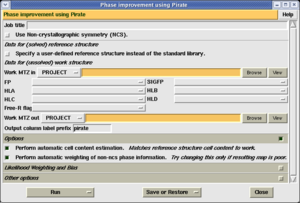Automated phase improvement with Pirate
From Media Wiki
Main Page - Using the CCP4 software - Phase improvement with CCP4 - Automated phase improvement with Pirate
Pirate is a program which takes an initial set of phase probability distributions from experiment phasing (or occasionally molecular replacement), and produces an improved set of phase probability distributions which may be used to calculate a clearer and more interpretable map. It does this by applying real space constraints based on known features of a protein electron density map.
Pirate is a statistial (as opposed to traditional) density modification method, and as such may produce less biased results. However the calculation is more time consuming than traditional methods, and very sensitive to the reliability of the error estimates from the phasing calculation.
- Reference: Cowtan K. (2000) Acta Cryst. D56, 1612-1621. General quadratic functions in real and reciprocal space and their application to likelihood phasing.
Contents |
[edit] Running Pirate
Pirate performs phase improvement to improve the phase estimates (or phase probability distributions) obtained from experimental phasing or molecular replacement, and thereby improve the electron density map. To run Pirate, you need an MTZ file containing a set of observed structure factors and phase information.
Open the 'Pirate' task from the Density improvement module. You can now enter the following information:
- The name of your MTZ file containing a set of observed structure factors and phase information. The phase information must be represented by Hendrickson Lattman coefficients. Select the appropriate columns generated by the phasing program. (When performing phase improvement after molecular replacement, you may only have a phase and figure of merit - this may be converted using the tool in the 'Reflection Data Utilities' module.
The remainder of the fields should be filled out automatically. Select 'Run now'. The calculation may take a few minutes to a few hours.
[edit] Program output
Pirate produces some dignostics in the output, including R-factors, E-correlations, and log-likelihood gains. However, while these may be useful for comparing different runs of Pirate, they do not generally give a good indication of how well the program has worked. The best ways to determine whether the resulting map is interpretable is to:
- Look at it in a graphics program, such as Coot.
[edit] Advanced options
[edit] Related pages
[edit] Program documentation
The latest version of the documentation is available here. This provides information on program keywords which may be used from the command line.
This page describes Pirate version 0.4.9 (CCP4 version 6.1.0).
--Kevin Cowtan 01:55, 21 April 2008 (CDT)
